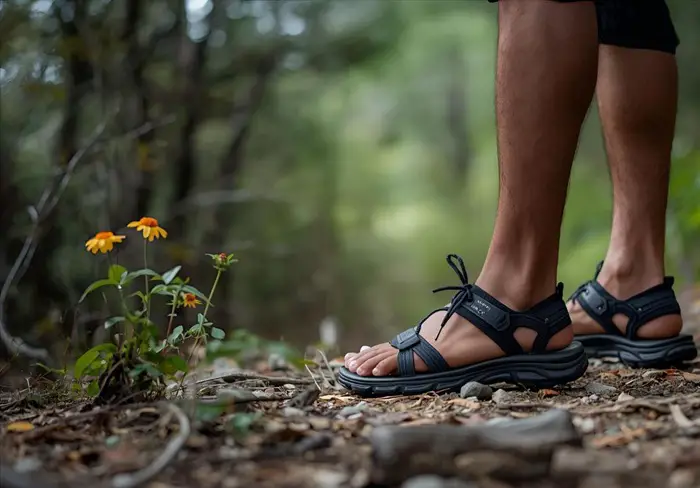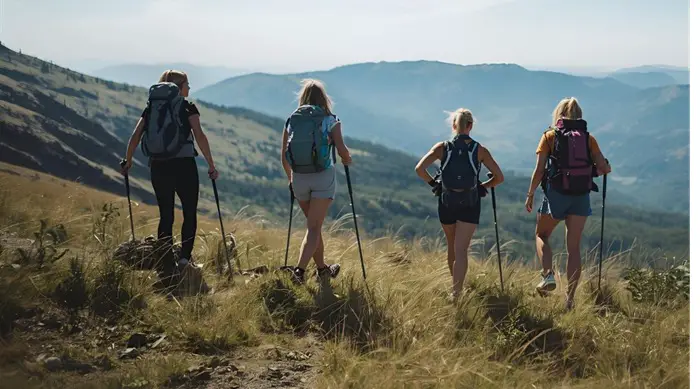
If you are planning a hike, then one of the concerns you should address is strengthening and protecting your ankles.
All too often, most people do not think about their ankles until they sprain them.
The sad part is that even a mild sprain can be quite painful and diminish your mobility, especially when out in the woods or outdoors.
Taking a few steps to protect your ankles can go a long way toward keeping them free of injury.
How to Protect Your Ankles When Hiking?
Here are seven proven ways to protect your weak ankles before you take that hike.
By doing a little prevention today, you can save your body from the pain and discomfort of spraining your ankles or worse.
1- Keep the Shoe Light
The better your support shoes for hiking, the more support you will get for your ankles. This means the support should run from the toes to the heel, and with plenty of cushions to absorb impacts.
Thick, heavy hiking boots are counterproductive since they pull on your knees and hips, making the hike even more tiring. Instead, look for shoes and boots that are made from strong but lightweight material.
The goal is to find footwear that offers the best protection while being as light as possible. This is especially true when you want breathable shoes or boots on your feet in the summer.
It’s also true in the winter, since slogging through snow or slush only gets worse when you are sporting heavy footwear. So, finding the right shoes or hiker ankle boots means going as light as possible for the least amount of strain on your legs.
2- Stick to Established Trails
This may seem less adventurous than dashing off into the woods, but trails are there for a reason.
A trail has been worn down with the dirt compressed to create strong support for your feet when you walk.
A good trail means less unevenness along the surface, which means less of a chance that you turn your ankle when walking.
Of course, not all trails are conducive to being flat, but you should look carefully when you first start walking to ensure that the trail will work for you.
If you should go off the trail, be extra careful so that you do not step on something that causes you to lose balance.
3- Wear Ankle Brace for Hiking
A hiking ankle brace that can be worn inside the shoes can be of great help to avoid spraining your ankles.
Not only does it provide your ankle the extra support it needs, but also the protection from any type of possible injuries caused due to ankle rolling or twisting.
Even though you have the best hiker ankle boots and trekking poles at your end, wrapping up your ankles with the best ankle brace for hiking is a crucial step.
This will make sure that you do not limit your activity by getting your ankles sprained too often.
4- Throw Away Worn Out Boots
If your hiking shoes or boots have seen better days, toss them out. A worn pair will only let you down when you need them the most.
At the very least, put the worn shoes aside for hiking and keep them around the house to wear casually.
It’s not surprising that many people grow attached to their hiking shoes or boots, but there comes a time when they can no longer be trusted when you are out in the woods.
Buying a good pair of hiking boots or gaiters is generally best as it supports the ankle to keep it from bending too much.
While many people dislike wearing boots, this may be the best choice for those with ankles susceptible to sprains.
5- Watch Your Step when Walking
This may be the most obvious, but it is also the most overlooked piece of advice for protecting your ankles during a hike.
It is very easy to get distracted when hiking. This is especially true when looking at your phone or a map if you enjoy such things.
Getting distracted means not looking where you are going, and the next thing you know, you are on the ground holding your sprained ankle.
It’s one thing to walk along a flat, smooth surface such as a concrete pathway, but they are few and far between on most hikes.
So, do the next best thing by stopping anytime you need to read a map or look at your phone. This will help prevent ankle sprains while walking. You are not likely to sprain your ankle standing still, so get into the habit of stopping first and then looking away.
6- Clean & Rest Your Feet at Regular Intervals
The point of hiking is to finish the journey, which means taking proper rest breaks and cleaning your feet when needed.
Hot, sweaty feet not only get tired quickly, but they also present a greater danger of slipping and spraining your ankle.
This means that every hour or two at most, take a rest break before your feet get overly tired and wash them.
A good creek is to quickly rinse off your feet but use canteen water if you have got it. A little care and attention before your feet get tired means that you can hike longer through the day.
7- Exercise and Strengthen Your Ankles
While the ankle is a joint, you can exercise the muscles that surround the ankle to provide better protection.
This means starting with shorter walks and simple exercises that increase the strength in the muscles of the legs and feet.
You should also add a little cross-training to help stretch and build strength when going in different directions.
You can strengthen the proper muscles by doing simple exercises such as calve raises.
Standing up on your toes while having some balance support can increase the strength in your lower legs. This, in turn, helps to keep your ankles in line and resist spraining.
If, despite the precautions, you sprain your weak ankle, all is not lost. Here is what you can do in case the ankle is sprained;
- Rest
- Ice
- Compression
- Elevation
Otherwise known as RICE, doing these four things will reduce the swelling, which will increase mobility on your sprained ankle. You will want to do this quickly to reduce the amount of swelling until you can get back home.
Once you are home, you should get medical attention if needed. Otherwise, let the swelling continue, as that is what is going to heal your ankle.
It may sound counterintuitive, but the swelling is the blood flowing to the ankle to heal it, so let your body do its job.

Can You Wear Sandals for Long-Distance Hiking?
Hiking in sandals can absolutely be done—and for some, it’s even more enjoyable than hiking in boots. But it’s not one-size-fits-all. Think about your trail conditions, your hiking style, and your own comfort.
For smooth summer trails, sandals can be a breath of fresh air (literally). For rugged, technical hikes, boots may still be your best bet.
When you picture long-distance hiking, chances are heavy-duty boots come to mind. But more and more hikers are swapping them out for sandals—and not just for short strolls.
Open-toed, trail-ready sandals are designed with adjustable straps, breathable materials, and rugged soles that promise comfort even on miles of uneven ground, especially when you wear and change the socks regularly inside.
So, is hiking in sandals just a trend, or can they actually carry you through the long haul? Let’s look at the upsides, the risks, and how to decide whether sandals are right for your next trek.
The Perks of Hiking in Sandals
- Breathability: On hot summer days, nothing feels better than the airflow sandals provide. No sweaty, suffocating boots—your feet stay cooler and drier.
- Lightweight Comfort: Sandals reduce foot fatigue since they’re typically lighter than boots. Over long distances, that can make a real difference.
- Quick Drying: Crossing streams or hiking in humid weather? Sandals dry much faster than traditional boots.
- Natural Movement: Minimalist hiking sandals encourage a more natural walking style, which some hikers find improves their balance and connection with the trail.
The Risks You Shouldn’t Ignore
- Less Protection: Exposed toes are vulnerable to stubs, cuts, and scrapes—especially on rocky or root-filled trails.
- Limited Support: Without proper ankle and arch support, long miles in sandals can increase the risk of sprains or fatigue.
- Blisters & Hot Spots: Straps can rub, particularly in humid or sandy conditions, leading to blisters.
- Not for Every Trail: Technical or rugged terrains often demand the stability of boots, no matter how comfy sandals feel.
What to Look for in Hiking Sandals?
If you’re tempted to give hiking sandals a shot, choose wisely. Look for:
- Adjustable Straps for a secure, custom fit.
- Rugged Soles with good traction for uneven terrain.
- Cushioned Footbeds to absorb shock.
- Moisture-Wicking Materials to reduce sweat and blisters.
- Closed-Toe Options if you’re tackling rocky or unpredictable trails.

Guide to Finding the Perfect Ankle Support for Hiking
Hitting the trail is always exciting, but let’s be honest—our ankles take the brunt of the adventure.
They’re constantly stabilizing every step, adjusting to uneven ground, and absorbing shock so the rest of the body can keep moving forward.
That’s why having the right ankle support isn’t just about comfort—it’s about preventing those little twists and strains from turning into something that sidelines your hiking plans.
Think of ankle support as your trail buddy, quietly working in the background to keep you steady and confident.
But here’s the tricky part: with so many ankle supports out there, it can feel overwhelming to figure out which one you really need.
Don’t worry—I’ve broken it down into clear, simple choices so you can pick the right support and focus on enjoying your hikes.
Types of Ankle Supports for Hikers
- Taping & Strapping: A lightweight method using adhesive tape or straps. Great for quick fixes, mild strains, or when you just need a bit of compression without bulky gear.
- Stabilizing Braces: These provide extra reinforcement and are especially useful if you’ve had sprains before or often tackle rocky, uneven trails.
- Custom-Molded Braces: Designed for serious injuries or chronic ankle issues. They’re tailored to you and offer maximum stability—like having armor for your ankles.
What to Consider Before Buying Ankle Supports for Hiking?
Before you settle on one, take a moment to think about:
- The severity of any current or past ankle injuries.
- How much stability and support you realistically need.
- The terrain you’ll be hiking—smooth trails or rugged mountains?
- Any ongoing ankle concerns that need extra care.
- Whether the support requires a “break-in” period before it feels natural.
Choosing the right ankle support means fewer worries about injury and more focus on soaking in the views, breathing fresh air, and making your hikes memorable. With the right support, your ankles will thank you every step of the way.
